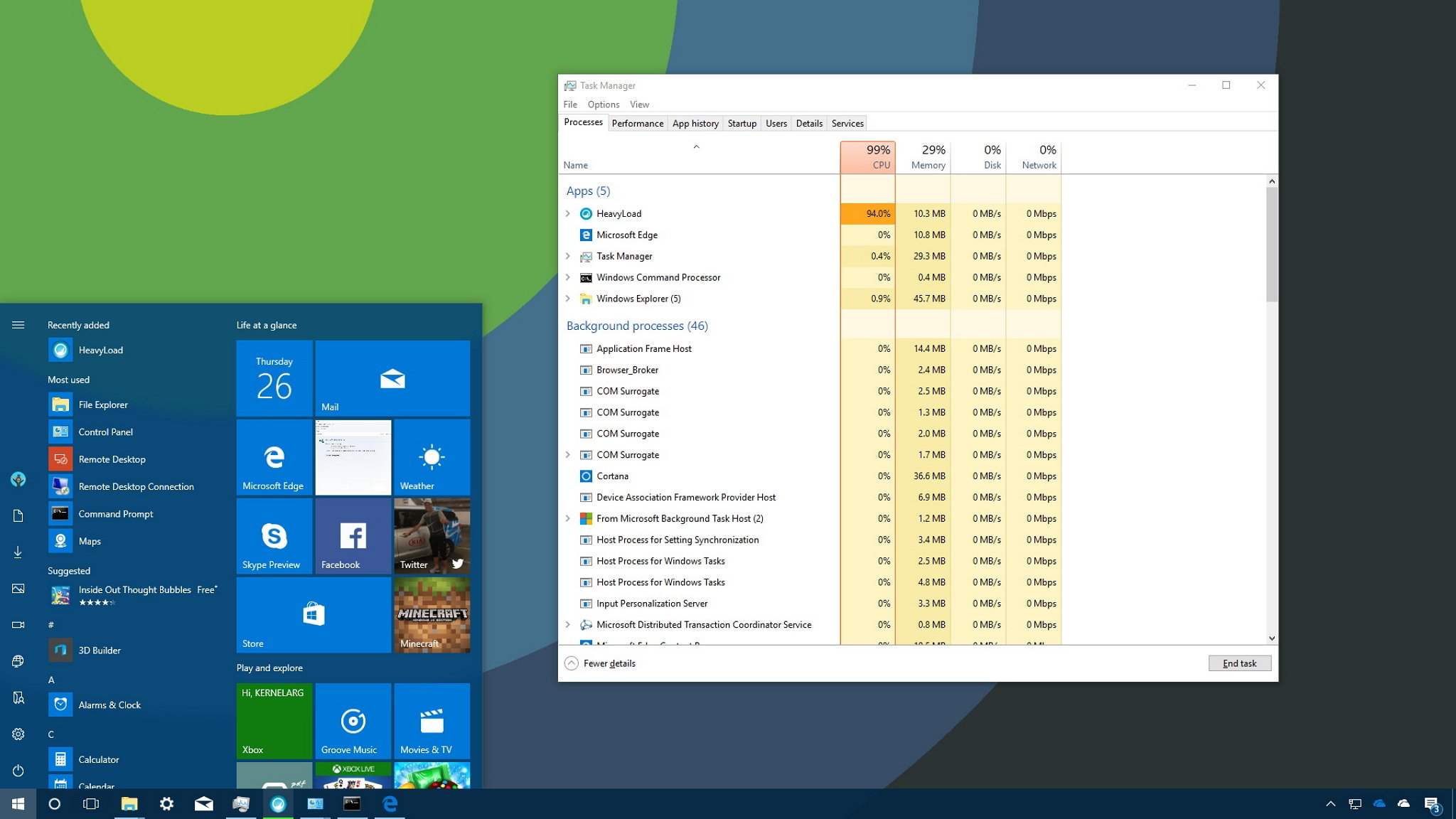how to see what is running on windows 10

The Chore Director is an avant-garde tool that comes with Windows 10, and information technology provides a number of tabs that allow y'all to monitor the applications, processes and services running on your computer. Notwithstanding, you'll likely find yourself using the Processes tab more than than anything else, because it lets y'all quickly see how system resources are utilized, which can be very helpful when trying to troubleshoot applications or find out why your computer is suddenly slow.
In this Windows 10 guide, we'll walk you through the steps to use Task Manager to place and cease processes that use excessive system resources, to keep your computer at top speeds.
How to use Task Managing director to manage high-resource processes
Opening Task Manager
If you lot want to use Task Manager to view and finish processes with high-resource usage, y'all first need to know how to open the tool. Here are a few means to open up Task Manager:
- Right-click the Taskbar and click on Job Director.
- Open up Start, do a search for Task Manager and click the result.
- Utilise the Ctrl + Shift + Esc keyboard shortcut.
- Use the Ctrl + Alt + Del keyboard shortcut and click on Task Manager.
- Use the Windows key + X keyboard shortcut to open up the power-user carte du jour and click on Task Manager.
If this is your first time opening Task Manager, the tool will probably open in meaty manner, which only lists running applications. Click the More than details button to access Task Director in advanced style.
 Chore Manager compact fashion (left), Task Manager avant-garde fashion (right)
Chore Manager compact fashion (left), Task Manager avant-garde fashion (right)
Understanding the Processes tab
When you're in advanced manner, you'll run into a number of tabs, including "Performance", "App history", "Startup", "Users", "Details", "Services", and the ane nosotros're interested in, the "Processes" tab. Typically, the Processes tab is the first place you desire to become to detemine which procedure is draining your computer's resource. This tab lists all the running processes in a single view grouped by "Apps", "Background processes" and "Windows Processes". On Windows x, you tin besides find multiple instances or other processes nether the same process, which helps you lot to better empathize how they're organized and how they utilise system resources.

You can ever expand a grouping to see all the processes past clicking the chevron-right icon or by correct-clicking the item and selecting Aggrandize. Usually, you'll encounter groups for Windows processes when opening multiple tabs on your spider web browser or multiple File Explorer windows, for example.
Identifying processes with high-resource usage
If an application is not responding, a website is taking a long fourth dimension to load, or your system fan starts getting loud, you can quickly utilise Task Manager to troubleshoot the problem. In the Processes tab, the first thing yous want to wait at is the percentage of the total resource employ for the processor, memory, difficult bulldoze and network. You tin click the column names to sort the list and bring to the pinnacle the ones using the near resources. If you lot meet whatever of these resources running high (ninety percent or college), you might accept found the problem.

Task Director also uses colors to highlight processes that use the most resources. You'll notice that equally a process starts to consume more than resources, the color begins to change from a lite- to a dark-shade of orange, making it easier to tell which 1 is causing the problem.
Typically, when you're non actively using applications and your computer isn't working on annihilation specific, such every bit maintenance, your total CPU usage should be less than 30 percentage. Applications that are running, even if you lot're not using them, and processes use office of your calculator's retentivity, and that usage will increase as you use or launch more applications. Memory unremarkably won't be an effect unless you run out of it, in which instance your computer will start using virtual retentiveness, and that can crusade your PC to slow down. Generally speaking, depending on your organisation configuration, your total retentivity usage should be beneath threescore percent. If you're non copying files or rendering videos, disk usage should exist below 5 percent.
Network connectivity is nearly never the reason your organization is wearisome, but in that location could be a problem in the network causing spider web content to accept a long time to load. If you're having problems downloading files, and you see "Network" stuck at 0 per centum, you may have an idea of what'south going on.
Stopping processes with high-resource usage
Later on yous place the trouble, right-click the process, and select End task to terminate it. Alternatively, yous can but select the item and click the End job button in the bottom-correct corner.

While stopping a procedure using the Job Managing director will virtually probable stabilize your computer, ending a procedure can completely close an awarding or crash your computer, and you could lose whatever unsaved data. It's ever recommended to save your data before killing a process, if possible.
If y'all're not sure about how the procedure you're trying to terminate affects your PC, you tin can right-click it, and select the Search online option. This action opens your web browser and displays a search issue with more than information most the process. Windows 10 is as well smart plenty to let yous know if you're about to end an essential system process that tin crash your computer.

Wrapping things upward
Although in that location are many other ways to troubleshoot system performance, Job Manager gives you an easy way to find out at a glance why your computer is slow or if an app is not responding, and then speedily act on information technology. You can end an awarding that isn't responding using Task Manager in meaty mode, just the advanced view gives y'all more than information about processes that are acting up in Windows 10.
More Windows 10 resource
For more assistance articles, coverage, and answers to mutual Windows 10 questions, visit the post-obit resources:
- Windows ten on Windows Cardinal – All you need to know
- Windows 10 help, tips, and tricks
- Windows 10 forums on Windows Central

Not Your Phone
Microsoft's Your Phone renamed Phone Link, and Accolade joins the fun
The Your Phone app for Windows PCs is undergoing a proper noun alter shifting to the more than advisable Phone Link. Likewise, the Android app changed from Your Telephone Companion to Link to Windows. Plus, Honour is now part of the exclusive club with avant-garde Telephone Link features.
Source: https://www.windowscentral.com/how-identify-and-terminate-high-resource-processes-using-task-manager-windows-10
0 Response to "how to see what is running on windows 10"
Post a Comment